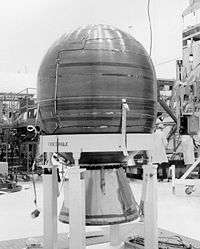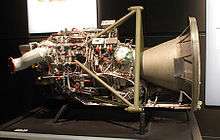Star 48
|
Star-48B rocket motor | |
| Country of origin | United States |
|---|---|
| Date | 1982 - present |
| Manufacturer | Thiokol |
| Predecessor | Star 37 |
| Solid-fuel motor | |
Star 48 is a type of solid rocket motor used by many space propulsion and launch vehicle stages. It is used almost exclusively as an upper stage. It was developed primarily by Thiokol Propulsion, and is now manufactured by Orbital ATK, which purchased Thiokol in 2001.[1]
The "48" designation refers to the approximate diameter of the fuel casing in inches; Thiokol had also manufactured other motors such as the Star 37 and Star 30. Internally, Thiokol's designation was TE-M-711 for early versions, and TE-M-799 for later ones. Subtypes are given one or more letter suffixes after the diameter number, or a trailing number (i.e., "-2") after the internal designation. Not surprisingly, the "T" prefix stands for Thiokol, and the following letter refers to the company division that developed the rocket motor. In this case, "E" refers to the Elkton, MD division and the "M" stands for motor.
The most common use of the Star 48 was as the final stage of the Delta II launch vehicles. Other launchers have also incorporated the motor, but with lower frequency. In such usage, the complete stage (motor plus accessories) is referred to as the Payload Assist Module (PAM), as the Shuttle could only take satellites to low Earth orbit. Because geostationary orbit is much more lucrative, the additional stage was needed for the final leg of the journey. On such missions, the stage is spin-stabilized. A turntable, mounted in the shuttle payload bay or atop the previous Delta stage, spun the PAM and payload to approximately 60 rpm prior to release.
Usually after motor burnout and just prior to satellite release the PAM is de-spun using a yo-yo de-spin technique.
A non-spinning, thrust-vectoring version of the Star 48 is available ("Star 48BV"), but much less common. A thrust-vectoring Star 48 is the final stage of the Minotaur IV+ launch vehicle.
A Star 48 motor used in the 3rd stage of the New Horizons probe was the first part of the New Horizons mission to reach Jupiter, arriving before the probe.[2] It also crossed Pluto's orbit in 2015 at a distance of 200 million kilometers.

A Star 48 Payload Assist Module that had been used to launch a GPS satellite in 1993 crashed in the Saudi Arabian desert in January 2001, after its orbit decayed. The unit did not burn up on reentry and was positively identified on the ground.[3]
In 2013 a Star 48GXV was tested for the Solar Probe Plus mission.[4]
References
- ↑ ATK Space Propulsion Products Catalog (PDF). ATK. 2012. pp. 99ff. Retrieved 2013-06-06.
- ↑ Derelict Booster to Beat Pluto Probe to Jupiter
- ↑ "PAM-D Debris Falls in Saudi Arabia" (PDF). The Orbital Debris Quarterly News. NASA Johnson Space Center. 6 (2): 1. April 2001.
- ↑ ATK and NASA Successfully Demonstrate New Rocket Motor for Solar Probe Plus Mission


